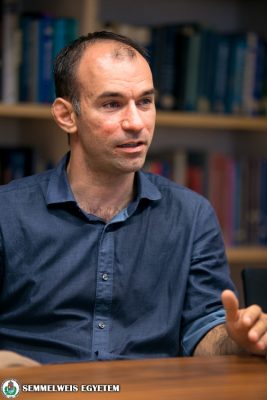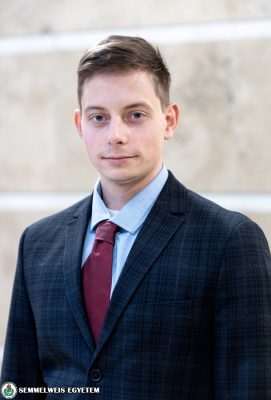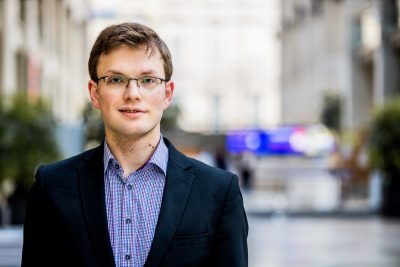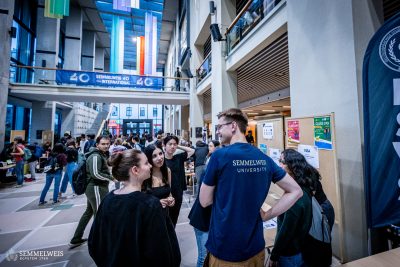 According to Dr. Levente Kiss, Director of the Center for Educational Development, Methodology and Organization, based on professional records, university projects and his own experience, there was a high demand for an immediate, on-the-spot student feedback, which serves the rapid, undistorted evaluation of the educational process only by those present, thus facilitating more effective educational development.
According to Dr. Levente Kiss, Director of the Center for Educational Development, Methodology and Organization, based on professional records, university projects and his own experience, there was a high demand for an immediate, on-the-spot student feedback, which serves the rapid, undistorted evaluation of the educational process only by those present, thus facilitating more effective educational development.
Recalling the launch of the QR code system, András Szögi, the developer of the program said that the program he supervised from the beginning debuted in August 2019 at the Summer University, when students used it to log in for credits. The project was initiated and developed under the leadership of Dr. Péter Hermann, Vice-Rector for Education. Then came a request from Dr. Miklós Kellermayer, Dean of the Faculty of Medicine (ÁOK), to introduce this type of feedback after lectures at the faculty.
 According to András Szögi, on-the-spot data sharing about the actual experience is completely different from the end-of-semester evaluation of the current semester, since the instructor has access to information that can immediately influence his/her teaching activities. “If, for example, it turns out that students think the pace of the lecture was too fast, the issue can be solved on the next occasion. There are 9 questions for the lectures and 10 for the exercises; furthermore, there is a possibility to express your opinion freely, and a ‘do not wish to answer’ button is available as well,” explained András Szögi.
According to András Szögi, on-the-spot data sharing about the actual experience is completely different from the end-of-semester evaluation of the current semester, since the instructor has access to information that can immediately influence his/her teaching activities. “If, for example, it turns out that students think the pace of the lecture was too fast, the issue can be solved on the next occasion. There are 9 questions for the lectures and 10 for the exercises; furthermore, there is a possibility to express your opinion freely, and a ‘do not wish to answer’ button is available as well,” explained András Szögi.
“The QR code system, which enables instant feedback, was launched on a broader university level in the 2020-21 academic year under the guidance of the Center for Educational Development, Methodology and Organization (OFMSZK),” Dr. Levente Kiss added. “At the end of lectures, lecturers project a unique QR code, which students scan with their phones to receive a questionnaire that they have 25 minutes to fill in,” the director explained. The system is already compulsory at the Faculty of Dentistry (FOK) and the Faculty of Medicine after lectures, and is increasingly being used after practices as well.
 “About 8000 students logged into the system through the Semmelweis University Central Identification (SEKA), where they filled in a total of 8030 questionnaires – this means almost 765 thousand entries,” the program developer pointed out. “The system includes 843 lecturers, which represents the majority of all lecturers at the institution. Feedback shows that students like the program, give useful evaluations and use it in large numbers,” he added.
“About 8000 students logged into the system through the Semmelweis University Central Identification (SEKA), where they filled in a total of 8030 questionnaires – this means almost 765 thousand entries,” the program developer pointed out. “The system includes 843 lecturers, which represents the majority of all lecturers at the institution. Feedback shows that students like the program, give useful evaluations and use it in large numbers,” he added.
On the use of QR codes, Dr. Péter Hermann, Vice-Rector for Education said that the advantage of the system relies in its speed, since after a lecture or tutorial, the code projected by the instructor can be scanned with a smartphone and the feedback was immediately provided. “The Faculty of Dentistry has had the highest participation rate of the whole university so far, and this feedback option has been very popular among students,” said Dr. Hermann. “One of the critical points of student feedback on teaching is who can read the evaluations received. In the end, we decided to make it available to the heads of department, but it will not be made public,” he added. “As of now, students’ opinions must be taken into account when preparing the rating of lecturers, and this is also laid down in university regulations,” Dr. Hermann stressed, underlining that the system supports positive discrimination, such as highlighting the best trainer.
 György Keskeny, a third-year student at the Faculty of Dentistry and the president of the Students’ Union responsible for e-learning, pointed out that more and more universities are placing great emphasis on feedback from teachers and students in terms of quality education. “One of the most important features of the QR code system is the emphasis on feedback from the student side,” he stressed. “I see that a feedback culture is emerging at Semmelweis University, and this fast, reliable and anonymous technical solution reinforces this,” he said.
György Keskeny, a third-year student at the Faculty of Dentistry and the president of the Students’ Union responsible for e-learning, pointed out that more and more universities are placing great emphasis on feedback from teachers and students in terms of quality education. “One of the most important features of the QR code system is the emphasis on feedback from the student side,” he stressed. “I see that a feedback culture is emerging at Semmelweis University, and this fast, reliable and anonymous technical solution reinforces this,” he said.
Ádám Szabó, Péter Pogrányi
Translation: Viktória Kiss
Fotó: Attila Kovács – Semmelweis University


